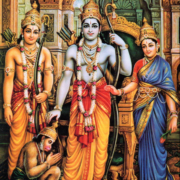How to Chant Mantras- part one
By Mahanidhi Swami
In the Bhagavad-gita Krishna says that among sacrifices He is japa yajna, the sacrifice of chanting japa. The Agni Purana defines japa thus: “The syllable “ja” destroys the cycle of birth and death, and the syllable “pa” destroys all sins (papa). Japa, therefore, is that which destroys all sins, stops the cycle of birth and death, and liberates the soul from bondage.”
There are three forms of chanting mantras. The third form is called uccaih or loud chanting, which specifically refers to Hari Nama Sankirtana, which benefits both the chanters and any who hears. The other two forms refer to chanting diksa mantras or Hare Krishna mantra on japa beads.
They are upamsu (audible) and manasika (mental). Upamsu means murmuring or repeating the mantra while moving the lips and making a slight sound or whisper. Manasika (mental or meditative) japa is done by concentrating upon the meaning of each word, along with meditating on the mantra’s full conception without moving the tongue and lips or making any sound.
In this regard, Manu-samhita says, “Manasika japa is a thousand times greater than upamsu japa.”
Indeed, manasika japa is the most powerful form of chanting mantras. But it is only possible for sadhakas who are pure, peaceful, and filled with goodness (sattva-guna). So one can easily understand that manasika japa, or silent meditative chanting is very difficult to perform in this age of anxiety, agitation and mental impurity. Therefore acaryas recommend upamsu japa, uttering the mantras quietly and very clearly in order to remove ignorance and lethargy from the mind.
According to the personal servant of Srila Prabhupada, Hari Sauri Prabhu, His Divine Grace did upamsu japa while chanting Gayatri. Thus, one should choose a chanting method based on his qualification and the order of the spiritual master.
Diksa mantras work and give results only when one maintains internal and external cleanliness. To chant successfully one must acquire the good qualities of tranquility, self-control, austerity, and cleanliness, e.g. twice daily bathing and wearing clean cloth.
Other perquisites for chanting success are mental purity, achieved by chanting the Hare Krishna maha-mantra, reciting prayers for identity purification (bhuta-shuddhi), and deep concentration on the meaning of the mantras. The next installment will explain more details to bring mantra perfection.
(Excerpt from Gayatri Mahima Madhuri by Mahanidhi Swami)
Diksa mantras ki jai!
Jai Jai Sri Radhe!





Lovely! Thanks for broadening the scope of Japa meditation! My obeisances!